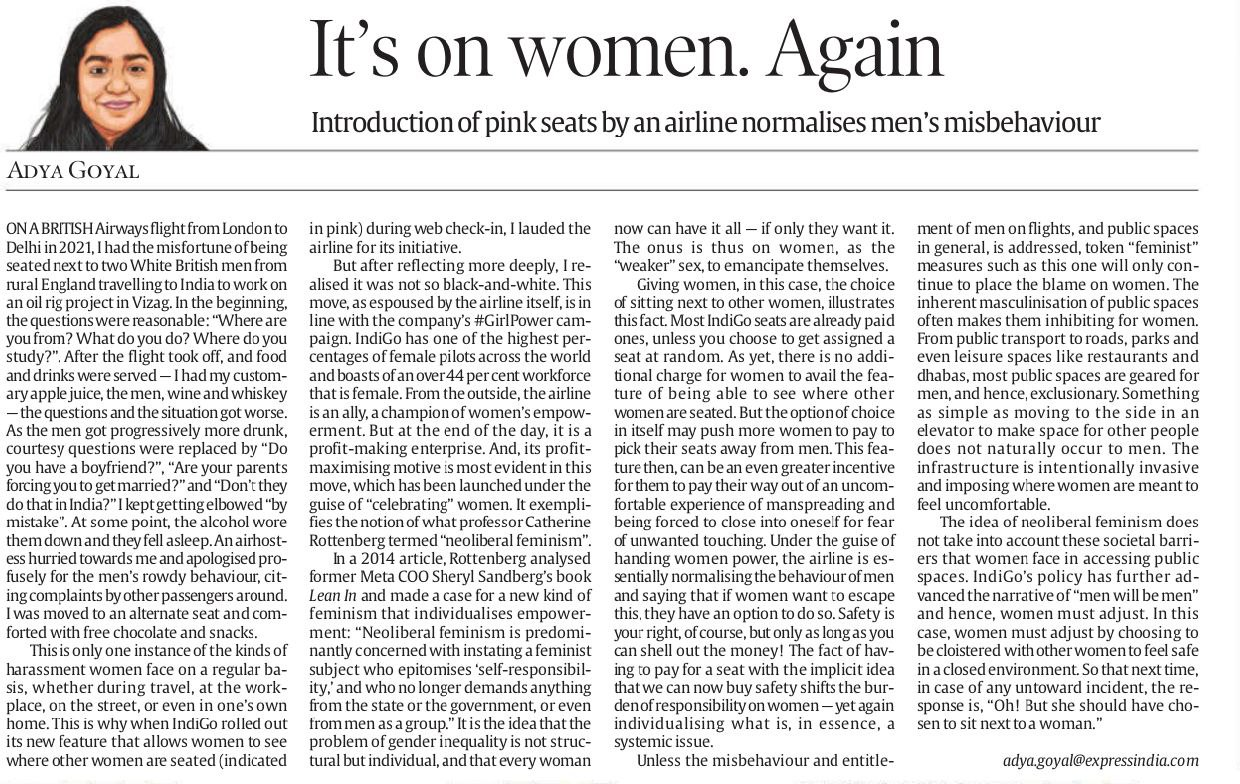1. Introduction of Pink Seats by an Airline Normalises Men’s Misbehaviour
Introduction:
The article addresses how gender-specific policies, like introducing pink seats on flights, place the responsibility of safety and comfort solely on women while failing to address the root causes of gender-based harassment. It critiques such moves as reinforcing patriarchal norms rather than challenging them.
- Personal Experience and Context:
- The author recounts an incident on a flight where she faced uncomfortable questions and advances from inebriated male passengers.
- While the airline staff addressed the issue, it reflects the broader issue of harassment faced by women in public spaces.
- Gender-Specific Solutions – Pink Seats:
- IndiGo’s Initiative: The introduction of pink seats by IndiGo to give women a “choice” to sit separately from men is an extension of their #GirlPower campaign.
- Underlying Critique: Although this might seem empowering, it places the burden of safety and comfort on women rather than addressing men’s behaviour. It perpetuates the narrative that women must adjust to avoid harassment.
- Neoliberal Feminism:
- The idea of “neoliberal feminism” promotes individual responsibility for dealing with systemic issues.
- It focuses on providing individual solutions (like pink seats) while ignoring the need for structural change to make public spaces safe for women.
- The concept is based on profit-making, framing empowerment in a limited way, and masking deeper issues of inequality and patriarchal control.
- Public Spaces and Gender:
- The article discusses how most public spaces, from flights to parks and restaurants, are designed to be exclusionary for women.
- Invasive and masculinised environments make women feel uncomfortable, with little thought given to inclusive infrastructure.
- Structural Solutions:
- To address gender inequality and harassment, policies should aim at changing the behaviour of men and making public spaces safer for all rather than offering tokenistic solutions like pink seats.
- The focus should be on systemic changes that shift the burden away from women.
Conclusion:
The introduction of pink seats by airlines like IndiGo may appear as a measure of empowerment, but it reinforces the patriarchal idea that women must bear the responsibility for their safety. To truly address gender inequality, there needs to be a shift in how public spaces are designed and managed, ensuring they are safe and inclusive for all, irrespective of gender.
Mains Practice Question:
|
Q: “Tokenistic gender-specific measures, such as pink seats for women, normalize harassment and fail to address the root causes of gender inequality.” Critically examine the role of public policies in addressing gender inequality in public spaces.
|
2. Allocations for Health, Outcomes in States
Introduction:
The health sector in India faces a significant gap between budget allocations and effective outcomes, especially at the state level. Centrally Sponsored Schemes (CSS) like the Pradhan Mantri Ayushman Bharat Health Infrastructure Mission (PM-ABHIM) and Human Resources for Health and Medical Education (HRHME) are designed to address health infrastructure but encounter several hurdles in implementation.
- Centrally Sponsored Schemes (CSS) for Health:
- PM-ABHIM: Focuses on building health and wellness centers, block-level public health units (BPHUs), and critical care hospital blocks (CCHBs).
- HRHME: Aims at establishing medical, nursing, and paramedical colleges and increasing seats in existing institutions.
- Both schemes aim to strengthen district hospitals and integrate public health laboratories to improve pandemic preparedness and healthcare infrastructure.
- Challenges in Fund Utilisation:
- Low Utilisation: Central expenditure for these schemes has been low, with utilisation rates around 50% of the budget estimates for 2022-23 and 2023-24. In HRHME, the situation is worse, with even lower utilisation levels.
- Complex Execution: The complex structure of fund distribution and the requirement of integrating local facilities under central schemes have delayed the progress. For example, guidelines on staffing norms, especially specialists, have not been followed effectively in rural areas.
- Factors Affecting Utilisation:
- 15th Finance Commission’s Health Grants: States have struggled to use 60% of these funds due to a lack of coordination between state and central guidelines, leading to delayed execution.
- Overlapping Responsibilities: Multiple funding sources and rigid protocols have led to operational inefficiencies in states.
- Faculty Shortage:
- The lack of teaching staff, particularly specialists, in medical colleges established between 2019-21 is a significant bottleneck. According to reports, 40% of teaching faculty positions remained vacant in 2022.
- Fiscal Space and State-Level Challenges:
- State governments will bear the long-term operational costs of maintaining infrastructure built under PM-ABHIM and HRHME. This necessitates adequate fiscal space and financial commitment from the states.
- The Union government will support human resources only until 2025-26, placing additional pressure on state budgets.
- Need for Streamlining:
- The success of these schemes requires significant reforms at the state level, with improved coordination, planning, and removal of rigid protocols.
- Key areas requiring attention include construction of infrastructure, solving faculty shortages, and integrating various healthcare schemes for better outcomes.
Conclusion:
The gap between health allocations and outcomes in Indian states arises due to low fund utilisation, complex operational frameworks, faculty shortages, and fiscal space constraints.
The success of centrally sponsored health schemes like PM-ABHIM and HRHME depends on robust state-level implementation, better planning, and addressing systemic challenges such as human resource shortages and overlapping responsibilities.
Mains Practice Question:
|
Q: “Centrally Sponsored Schemes (CSS) for health, such as PM-ABHIM and HRHME, face hurdles in state-level implementation and fund utilisation.” Discuss the key challenges and suggest measures to ensure better health outcomes through effective use of allocated funds. |



